 |
 |
Breakthrough thinking, continuous improvement. This is the foundation that all
Rocky Mountain bikes are built upon. Whether it is our new ETSX platform or
our tried and true 3D Link' system, every bike is developed in house:
designed, prototyped, tested, improved. The handcrafted quality that is inherent
to our bikes is the result of countless hours of research, design and testing.
|
| ETSX Energy Transfer System Explained |
TOP |
 |
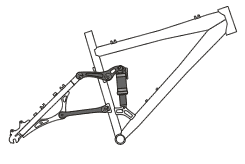 Based on the wishbone suspension found on Formula-1 race cars, patented ETSX
suspension features a unique, double A-arm style linkage that creates an optimized projected pivot point located
in front of the bike. The result is near perfect vertical rear-wheel travel
and optimized chain growth. Vertical travel eliminates "hooking",
enabling the wheel to better roll over rough terrain. The linkage uses high-quality
cartridge bearings in every pivot resulting in suspension performance that reacts
instantaneously to even the smallest bump, so finely tuned that it actually
helps drive you forward as you pedal over rough terrain.
Based on the wishbone suspension found on Formula-1 race cars, patented ETSX
suspension features a unique, double A-arm style linkage that creates an optimized projected pivot point located
in front of the bike. The result is near perfect vertical rear-wheel travel
and optimized chain growth. Vertical travel eliminates "hooking",
enabling the wheel to better roll over rough terrain. The linkage uses high-quality
cartridge bearings in every pivot resulting in suspension performance that reacts
instantaneously to even the smallest bump, so finely tuned that it actually
helps drive you forward as you pedal over rough terrain.
|
 |
| 3D Link Suspension Explained |
TOP |
 |
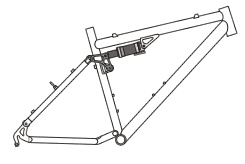 For the last seven years we've used 3D Link Suspension Technology to meet the
lightweight, lateral stiffness demands of serious cross-country riding. The
key has been the beautifully simplistic design of a suspension system that doesn't
rely on the shock as a structural component of the frame. As a result, lateral
stiffness rivals that of a hardtail. As well, the power of each pedal stroke
is transferred directly into the drivetrain. No energy sucking "bob",
just plush travel when you need it and a wheel that sticks to the ground like
glue.
For the last seven years we've used 3D Link Suspension Technology to meet the
lightweight, lateral stiffness demands of serious cross-country riding. The
key has been the beautifully simplistic design of a suspension system that doesn't
rely on the shock as a structural component of the frame. As a result, lateral
stiffness rivals that of a hardtail. As well, the power of each pedal stroke
is transferred directly into the drivetrain. No energy sucking "bob",
just plush travel when you need it and a wheel that sticks to the ground like
glue.
The award winning 3D Link system is revered the world over, withstanding the
rigors of thousands of riders to create a quiet revolution of simplicity in
design. Looking at a Rocky Mountain 3D Link bike you won't see a motorcycle,
or funky frame design with tubes running in crazy directions. You see a bicycle,
one with the inherent strength of the simple double triangle shape that has
been the standard bike geometry for the past 100 years. It is the lightest,
stiffest, and most durable way to produce a bicycle frame. With 3D Link we've
just added suspension to a frame design that has withstood the test of time.
The end result is a ride that is quick and light, without sacrificing lateral
stiffness, frame strength, or durability.
|
 |
| ThrustLink Suspension Explained |
TOP |
 |
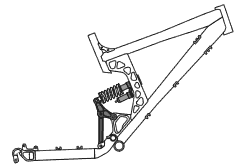 We've been improving on ThrustLink since it first appeared on our big travel
full suspension bikes four years ago. Since then, ThrustLink technology has
emerged as one of the most responsive suspension systems on the market. It is
one of the first rear suspension systems to eliminate pedal feedback from bumps
and chain tension--reacting quickly and smoothly to small aberrations without
sacrificing performance on the big hits or losing pedal efficiency. It's all
due to a pivot point located above and behind the bottom bracket, an innovation
where reaction forces from the pedals don't cause the suspension to extend or
compress. A linear compression rate through the first half of the suspension
travel, and then a slightly rising rate for the last half results in a long,
smooth ride.
We've been improving on ThrustLink since it first appeared on our big travel
full suspension bikes four years ago. Since then, ThrustLink technology has
emerged as one of the most responsive suspension systems on the market. It is
one of the first rear suspension systems to eliminate pedal feedback from bumps
and chain tension--reacting quickly and smoothly to small aberrations without
sacrificing performance on the big hits or losing pedal efficiency. It's all
due to a pivot point located above and behind the bottom bracket, an innovation
where reaction forces from the pedals don't cause the suspension to extend or
compress. A linear compression rate through the first half of the suspension
travel, and then a slightly rising rate for the last half results in a long,
smooth ride.
For the main pivots we use high-strength, sealed needle bearings for super subtle
responses in all conditions. The swingarm features a new cold forged, CNC machined
yoke and a one-piece cold forged, CNC machined BB/Pivot shell, drastically improving
lateral stiffness. Instead of using a single row ball bearing, which only supports
radial loads, new double row bearings are now used on all the main pivot points
to additionally support side loads. ThrustLink' - it rides like nothing
else.
|
 |
| Switch 4-Bar Suspension Explained
|
TOP |
 |
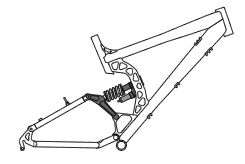 The Switch seamlessly blends two suspension frame technologies into a completely
new platform. By combining the Easton RAD tube front end of the RM7 with a new
triangulated 4-bar linkage the Switch offers amazing versatility in a freeride
bike. Combine this bombproof frame with the new 1.5" headtube and fork
steerer and you have an all purpose freeride platform. The 1.5" headtube/fork
steerer interface is the freeriders' identity badge offering triple clamp
stiffness and travel with the weight and dexterity of a single crown. It couldn't
be any better. To match the awesome new 1.5" front end, the 2003 Switch
features a new linkage design that generates a full 6" of rear wheel travel.
The Switch seamlessly blends two suspension frame technologies into a completely
new platform. By combining the Easton RAD tube front end of the RM7 with a new
triangulated 4-bar linkage the Switch offers amazing versatility in a freeride
bike. Combine this bombproof frame with the new 1.5" headtube and fork
steerer and you have an all purpose freeride platform. The 1.5" headtube/fork
steerer interface is the freeriders' identity badge offering triple clamp
stiffness and travel with the weight and dexterity of a single crown. It couldn't
be any better. To match the awesome new 1.5" front end, the 2003 Switch
features a new linkage design that generates a full 6" of rear wheel travel.
|
 |
| ST3 Geometry Explained |
TOP |
 |
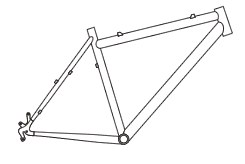 When we first started building bikes it quickly became apparent that traditional
frame geometry wasn't going to cut it on the steep descents and tight turning
singletrack of southern British Columbia. To help tame this rugged landscape
we developed ST3 Geometry - or Sloping Top Tube Technology. A sloping top tube
means increased frame stiffness and strength, and when things aren't going so
well, more stand over height for crucial dismounting ease.
When we first started building bikes it quickly became apparent that traditional
frame geometry wasn't going to cut it on the steep descents and tight turning
singletrack of southern British Columbia. To help tame this rugged landscape
we developed ST3 Geometry - or Sloping Top Tube Technology. A sloping top tube
means increased frame stiffness and strength, and when things aren't going so
well, more stand over height for crucial dismounting ease.
The frame layout creates a compact front end, giving increased agility in tight
turning singletrack while providing increased stiffness for greater control
in all conditions. It's also bomber construction: with a greater separation
between the top tube/seat tube and seat tube/seat stay welds, frame stress is
distributed over a larger area of the seat tube. Originated by Rocky Mountain
and copied by others, ST3 delivers a better handling, stronger frame - the ride
of a lifetime.
|
|
 |
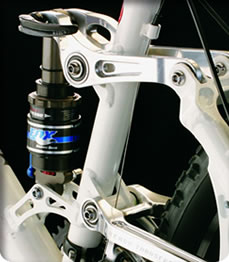 |
|
|
